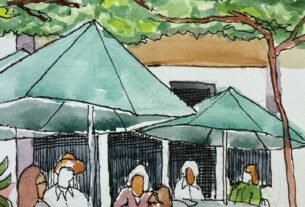The mangrove swamps of Mexico’s Pacific Coast shelter a seldom-visited jewel of a day-trip destination.
Legend has it that the man-made island city of Mexcaltitan, was Aztlan, the ancient home of the Aztecs, and that it was here a priest had a vision of an eagle perched on a nopal cactus, eating a serpent, which he interpreted as orders for the Aztecs to head south. By 1325 they had settled in Tenochtitlan, now Mexico City, nearly 700 miles to the southeast. Mexcaltitan may or may not be Aztlan, or the “cradle of Mexico,” as it likes to call itself. The town’s other favorite nickname is “the Venice of Mexico,” which is stretching it a bit, although summer floods and rains do turn the streets into canals, and force the inhabitants to build their sidewalks two to three feet above street level.
On my last visit, I still had one foot in the boat, which had brought us over from a mainland dock with a load of supplies, and the other on the swaying dock, when the first friendly native approached, offering a guided tour.
It wasn’t a first visit, so I knew one hardly needed a guide to the tiny island city. We thanked our would-be guide warmly and gave him enough pesos to buy a beer (clearly not his first of the day), then set off for the main plaza, past a couple of open-air restaurants where groups of men lounged with their late-morning beer and snacks. Along the four blocks to the plaza, I fended off more willing guides with an authoritative wag of my forefinger, a Mexican gesture that stops any unwanted activity dead in its tracks.
On this late winter day the streets were dry, and we elected to walk in them, avoiding the climb up and down at every intersection, and leaving the sidewalks to trays of drying shrimp and prowling cats.
The town is laid out like a wheel, with the plaza at the hub, with the church of Saints Peter and Paul on one corner, a tiny but choice museum diagonally across. In the center is a lacy wrought-iron gazebo and, to one side, a statue my companion dubbed “the sexiest Madonna in Mexico.” Unlike the better-known sexy Madonna, this one is white plaster; on her rounded hip she holds a chubby infant who tugs at her flimsy sculpted gown. Both mother and child are so animated, so saucy, one wonders what silver-tongued artist talked the town into accepting them. Perhaps they’re a relic of Mexcaltitan’s pagan days, when it’s said to have been a center for moon worship.
Inside the church, the mood is typically solemn despite the swallows that dart among the eaves. Wax statues of Christ and saints with somber expressions on their pale faces stare from glass cases. In a room to the side of the altar is a crucified Christ with long black hair blowing in the breeze. Saints Peter and Paul come out on July 25 and 26 and are treated to a boat race around the island during the celebration of its patron saints’ days.
In the museum, island history is traced from the earliest inhabitants, about 4,000 years B.C., to the present, in dioramas, photos, paintings and exhibits of local flora and fauna. The displays do not include the explanation of the Aztecs’ departure, which author Gary Jennings relates in his often-bloody, often-hilarious, novel Aztec. There, a visitor wonders why the Aztecs left such a beautiful, fertile land and the mayor informs him they had no choice: The town kicked out “those bloodthirsty savages.”
Mexcaltitan’s 1,300 inhabitants, like those of most Mexican villagers, live in concrete block houses, some stuccoed, some not, which make a solid wall along the sidewalks. As we walked towards the far side of the island, open doors revealed an occasional courtyard brimming with tropical plants and the day’s laundry, high-backed chairs surrounding baronial-size dining tables, and many front rooms crowded with beds.
A perimeter street circles the island. Here we spotted a nameless hotel and asked to see the rooms. All six were simple but immaculate and airy; most had views of the water and a luxuriant back garden blazing with orange and magenta bougainvillea. Rooms offered accommodations for two to six people If I had a reason to spend the night in Mexcaltitan, I wouldn’t hesitate to stay there. The owner told us he hadn’t been full, except for the Saint Peter and Paul celebrations, since the eclipse of July, 1991, when observers converged from around the world, filling not just his hotel but the many new rooms built in private homes just for the eclipse.
Another three blocks or so along the street, we found the restaurant open (not always the case) and vibrating with activity. A big Mexican party, which we took to be a family of three or maybe even four generations, occupied the center of the open-air dining room. A boom box at the bar to one side filled the air with dance music, and the floor with dancers: young couples, old couples, little boys with grandmothers, little girls with grandfathers, little girls with other little girls.
Outside, long-necked olive cormorants dove and surfaced with a gleaming mouthful of wriggling fish. Our view across the water was to another island, where humble houses of palm thatch and sticks teetered on the beach.
Salt-water breezes competed for our attention with rich food aromas, frying fish and hearty soup dominating. We ordered a local specialty, soup with shrimp meatballs to start, and fish (meaty robalo, or sea bass, that day) in garlic butter to follow. One or the other would have been plenty.
Mexcaltitan is in the heart of Mexico’s Marisma Nacional, or National Swamp, about midway between Teacapan (just south of Mazatlán) in the north and San Blas in the south. In its southern reaches the swamp is movie-bayou country, thick with mangroves, exotic birds, alligators and turtles. Towards the north it thins out and becomes marshland. Throughout, it’s a fertile breeding ground for shrimp, oysters and fish, succulent raw materials for talented cooks.
During lulls in the music, we fell into conversation with a man at the next table, a native of Mexcaltitan, who now lives in California’s Central Valley. “They don’t get a lot of foreign tourists here,” he told us, adding that it’s a popular day-trip for residents of nearby towns, especially on Sundays, when todo México heads for the nearest coast and a long afternoon’s feast. Many of the residents, he said, have never left the island, content to pass their lives in tropical peace and ignore the outside world.
Well, not quite, we discovered as we walked back to the dock in late afternoon. Except for the cats, staring at the drying shrimp, the streets were deserted. And they would have been silent, but from nearly every home reverberated the current telenovela, the soap operas with endings which have captivated Mexico’s housewives, saturating the ancient village with sounds of distant melodrama.
Practical matters
- Getting there:
- Approximately 200 kilometers south of Mazatlán, turn west from Hwy. 15 to Santiago Ixcuintla; about 5 miles from the highway. Drive through the town and another 6 miles to El Carrizo, where the road turns northwest for 6 miles through Sentispac, and becomes a good graded road for 10 miles to La Batanga, the boat landing. Fare to the island by motor launch (about 20 minutes) or dugout canoe (an hour or more) is negotiable. Buses run to La Batanga from Santiago Ixcuintla; schedules and fares change frequently. Alternatives are to hire a taxi in Santiago Ixcuintla or to make the trip by boat (open panga) from Teacapan, approximately a four-hour trip, and plan to spend the night on the island.
- Where to stay and eat:
- Island restaurants and the one hotel are nameless and have no telephones.
- More information:
- José de Jesús (Pepe) Morales or Carol Snobel, Hotel Denisse, Teacapan, Sinaloa, telephone (from U.S.) 011-52-695-954 5049.


